How we do a USD Fork swap / conversion.
USD Fork swaps on motorcycles have become a staple in the custom community. With a bit of work, some careful measurement and a few hours you can completely change the way your bike handles, brakes and looks. Sounds like only positive things can come from this right? Then I wonder why there’s such a huge negative stigma around this particular modification and an unbelievable amount of misinformation.
This article will take you through all the things I consider when doing a fork swap on my custom bikes at Purpose Built Moto. Be aware of your local laws and regulations around this sort of work, and do your homework if you’re going to try it out. Make sure you’re not going to end up with a half baked bike you can’t register or is unrideable. It’s a big topic and I’ll do my best to run through it all. This isn’t a how to guide, but more a sharing of my process that will hopefully help you through yours.
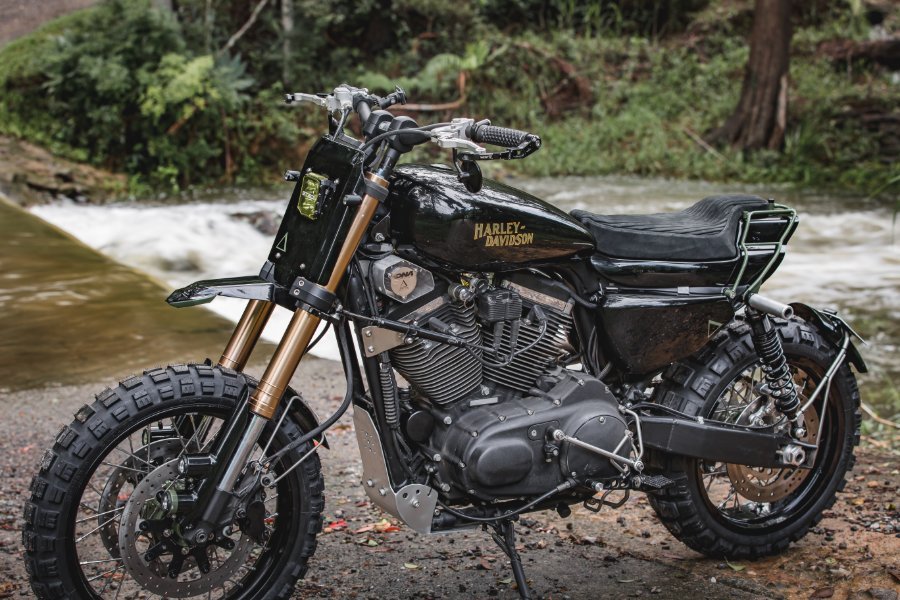
Aside from putting pod filters on your bike, no other topic seems to generate so much chatter (read – Bullshit) about the pro’s and con’s of swapping your motorcycles standard fork for a set of more modern USD forks. Place a post on any forum and you’ll have a host of “experts” discouraging you from doing it, telling you to make sure you get your geometry right and to not fuck it up. All this noise can be discouraging to any new builder, and it certainly was for me.
Knowing what I know now, I can tell you that most of the people that warn you off it, actually have no fucking idea what they’re talking about. They can mention words like rake, trail and caster but when you dig a little deeper their knowledge runs dry faster than a $5 beer tap on Friday afternoon. I can say this undoubtedly because I ran a test on my Instagram. I asked, “whats the most important thing when doing a USD fork swap?”
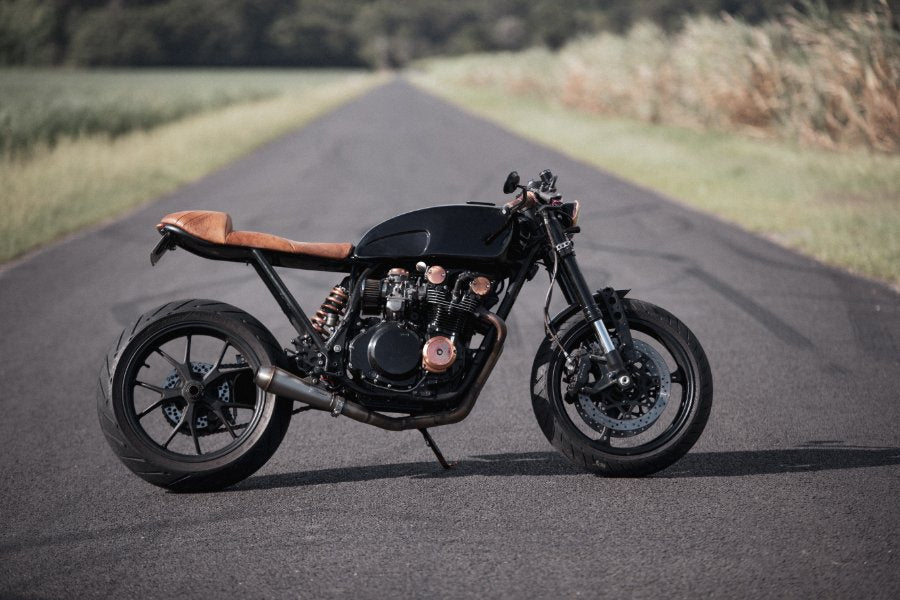
I had about 65 people respond, nearly all of which said either “correct geometry” or “rake and trail”. That’s right, it is really important.
These guys were then asked “what are your standard parameters or measurements you work toward? Rake or steering angle and trail?”
4 guys came back with various answers that were pretty good, explaining there’s a margin that most bikes work within depending on the type of bike. The rest flailed, diverted or said they are no experts but people should know before trying it themselves. So, of the people that were quick to jump on the wagon and try to prove what they know, 6% of them were the sort of guys you should take advice from, and 94% should have kept their mouths shut.
The 94% would be the first ones to jump on a comment train and warn you off doing it if you’re a novice, and place themselves in a position to discourage you from having a go. There is nothing worse than a dick head that’s read a few forum posts pretending to know more than they do.
To further that point let me say that I’m not a qualified mechanical engineer with all the answers. What I do have is a fair few of these swaps under my belt, and some experience I can share. In my time with Purpose Built Moto I’ve done numerous fork swaps on a number of different bikes. They all worked, not by luck but from careful consideration to what I was doing, and taking the time to do my due diligence before tackling it.
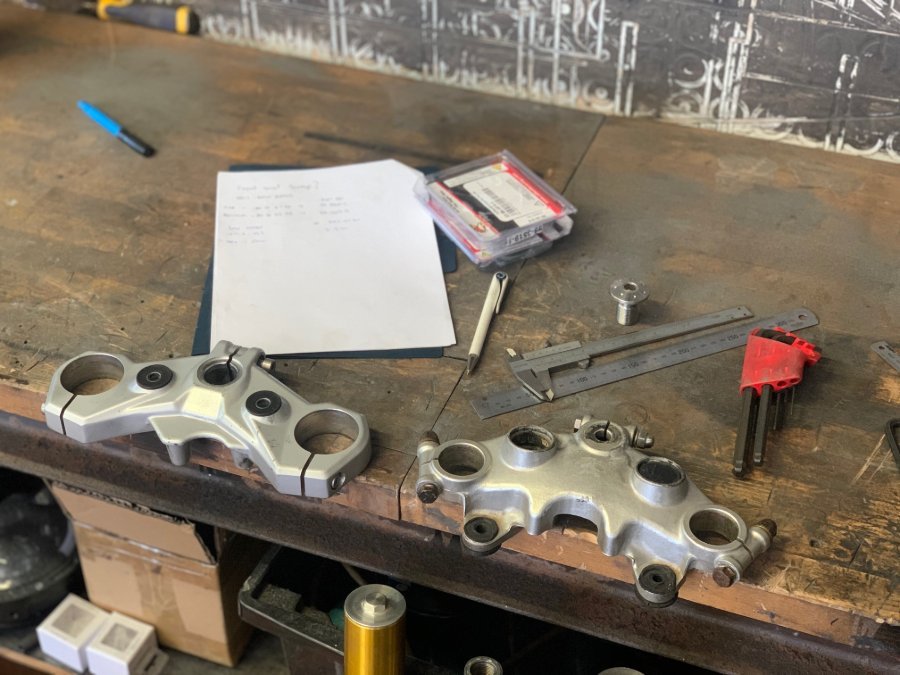
My Background is in Electrical, what I know about motorcycles I’ve learnt myself with a bit of research but mostly in the real world by doing. That means, you can too. But be real with yourself about your knowledge and skill set and if you aren’t up for it ask for help, or tread on the side of caution. Someone will always be willing to lend a hand if you’re genuine in your request and have taken the initiative to try and learn before reaching out for help.
Now let me get into the bones of USD fork swaps on a motorcycle.
Why do a USD fork swap on your custom bike?
There is a list of reasons that builders do this modification on their projects, each of them is as important as you deem it. If you achieve what you want out of it then that’s all that matters, even if it is just for looks.
My reasons for slapping a modern USD front end on a custom Café Racer or Scrambler looks like this in order of priority:
- Handling or switching the riding style (making a Sportster a Dirt Bike for example)
- Braking upgrade
- Cost of repair (explained below)
- Wheel swaps
- Styling
Normally the styling won’t play a part in the USD fork swap equation, but I wont lie to myself, or you. It can creep into mind on certain projects.
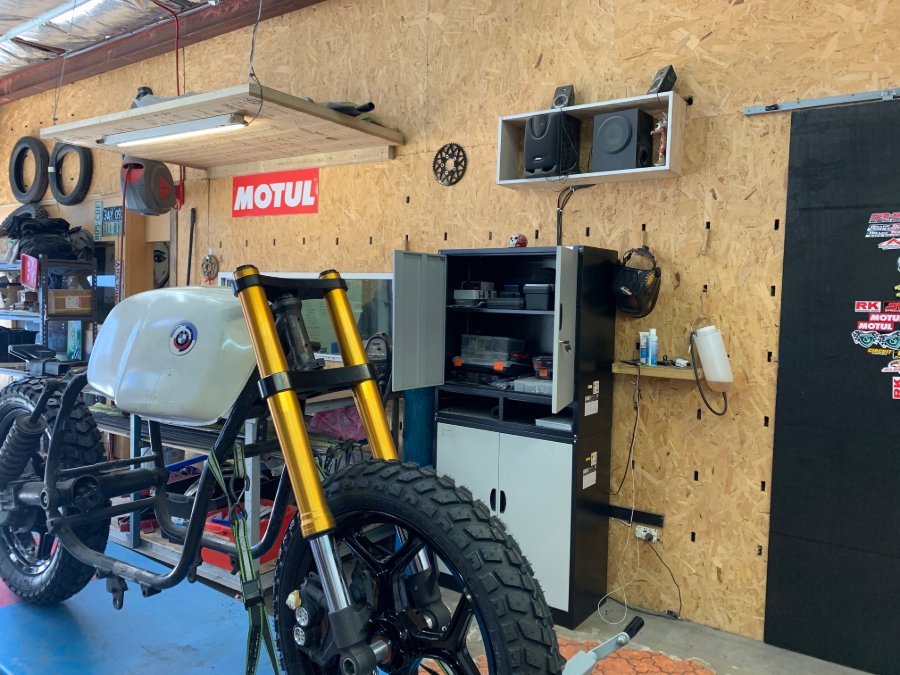
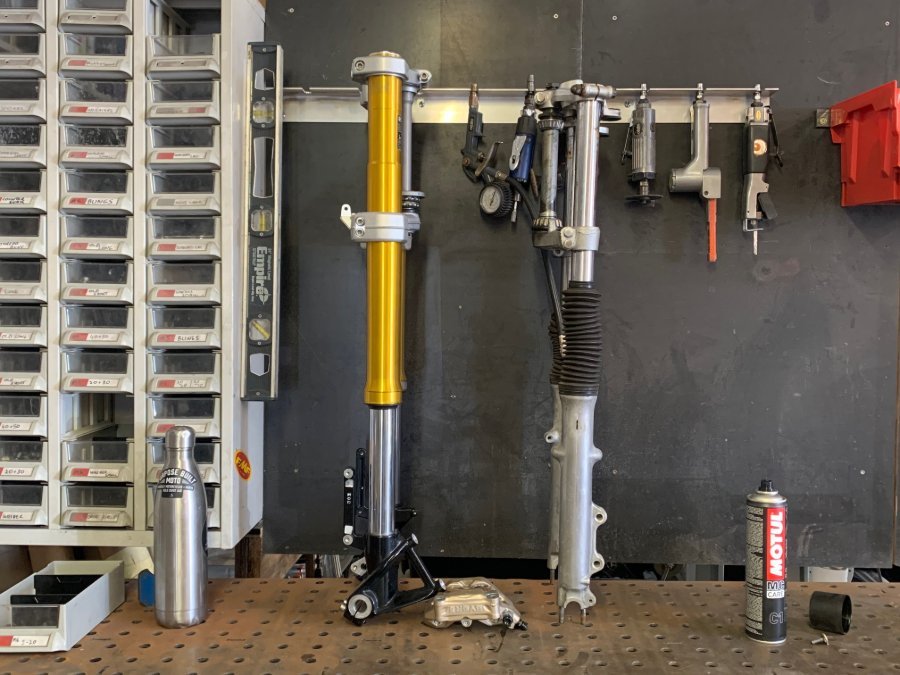
All of these are pretty self explanatory except for cost of repair. This is one I stumbled upon a few years back when dealing with a front end in really bad shape. To bring this set of forks back from the dead it would have needed:
- Rechroming ($300)
- New headstem bearings ($60)
- Springs replaced ($250)
- Fork legs stripped and repainted or polished ($200)
- Calipers rebuilt, new rotor and pads ($300-350)
Total – Approx $1200
As a builder, my job is to create the absolute best fucking bike I can for the given budget. Looking at these numbers my logic ran like this. I can spend $1200 and have a refreshed front end that handles like a set of forks in 1983. Alternatively I can do a bit of research find a 2017 front end, off a bike with a similar weight, offset and steering angle spend $1000 on that + $60 in bearings. As a bonus my customer gets a far better brake calliper, rotor and a front end designed with the knowledge and technology held in 2017. That my friends I called a no brainer. At the absolute worst the forks may need to be tweaked to suit the new bike and rider weight (most front ends are now adjustable) and I’ll spend a bit of time making the old wheel fit on the new front end but only if the wheels aren’t matched to start with.
A lot of these problems can be solved with a deep dive before you ever purchase a front end. Which leads me to my next point.
-
Headlight Mounting Kit Black
通常価格 $90.00通常価格単価 あたり$90.00セール価格 $90.00 -
7" FLASHPOINT CLASSIC LED HEADLIGHT BLACK - PURPOSE BUILT MOTO
通常価格 $330.00から通常価格単価 あたり$330.00セール価格 $330.00から -
7" FLASHPOINT LED HEADLIGHT BLACK - PURPOSE BUILT MOTO
通常価格 $320.00から通常価格単価 あたり$320.00セール価格 $320.00から -
Flashpoint LED Headlight 5.75" Black
通常価格 $320.00から通常価格単価 あたり$320.00セール価格 $320.00から -
Flashpoint Classic LED Headlight 5.75" Black
通常価格 $325.00から通常価格単価 あたり$325.00セール価格 $325.00から
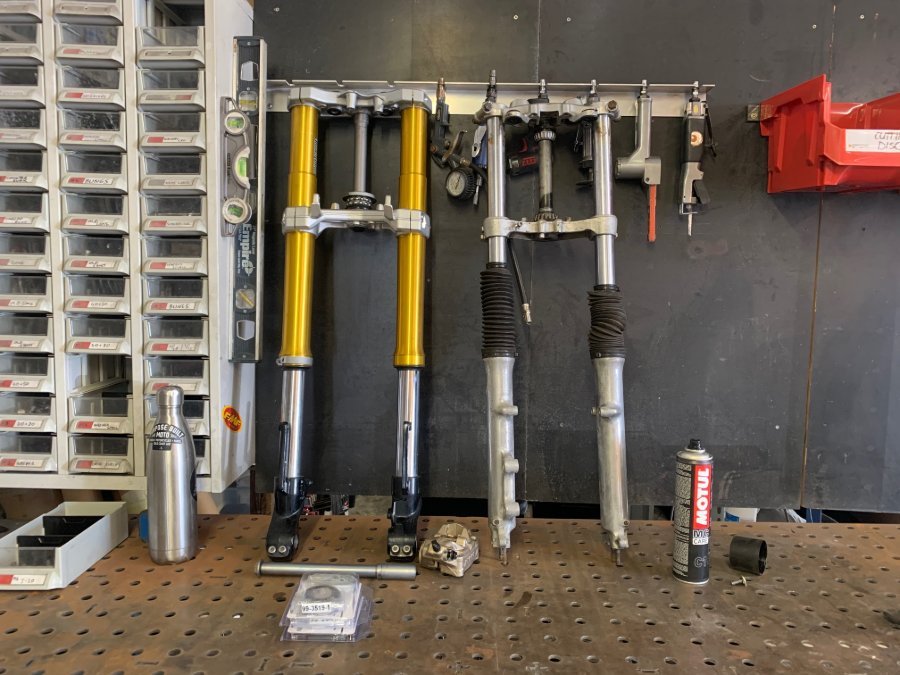
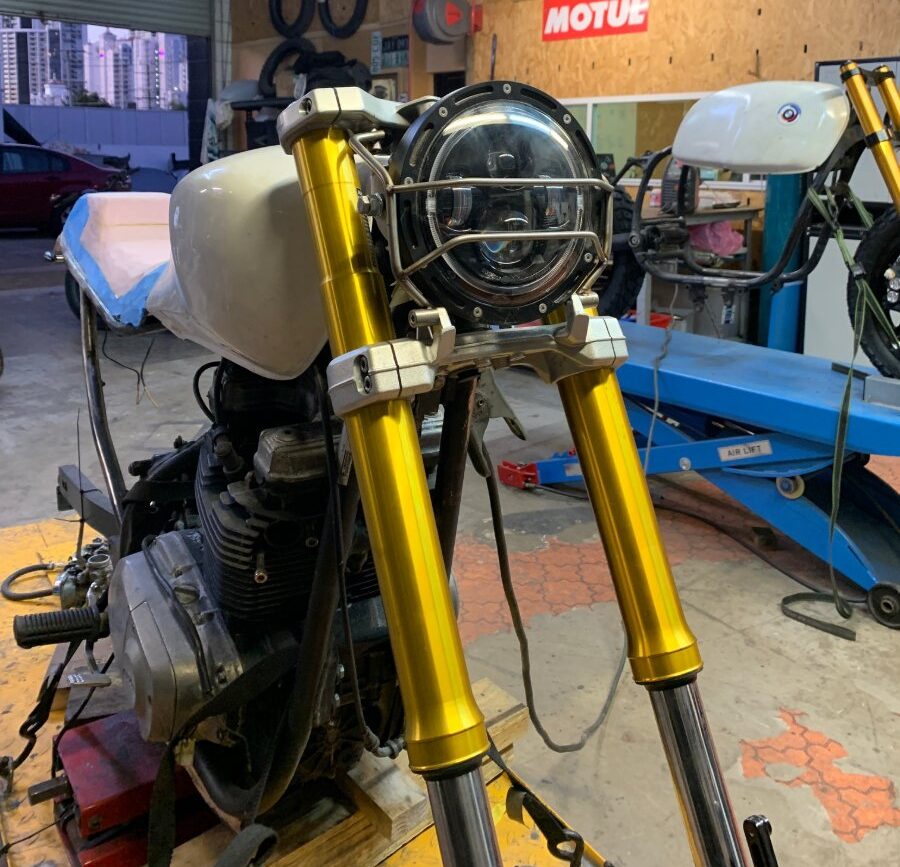
Choosing the right front end for your USD fork swap
All too often I see guys buying a front end because that’s what they’ve seen someone else do online, with no forethought on if its actually suitable. It might have worked for this internet stranger, but is it your actual best option?
Again this comes down to doing your due diligence and putting the time in up front to make sure its right. If you’re building a Café Racer or total street bike, sure a GSXR front end is going to cut it. If your USD fork swap is for a scrambler or adventure dual sport then a sport bike front end is probably not the best choice.
Here’s a quick few hits of knowledge on modern front ends:
- Modern sport bike forks are often quite a bit shorter than your CB750 forks or those on older street bikes. The frames are built very differently. GSXR600 forks are a very popular option for swaps. I think this is because they’re about 20mm longer than the other brand equivalents. Be aware doing a front end swap will drop your bike low on the front unless you counter it with fork extensions or an offset top triple clamp.
- Often USD forks have a lot less offset than your older front ends. The relationship between offset and trail we will get into later, but just be aware this effects the amount of radius you can get from your steering unless you modify or move the tank.
- Offset can be gained from either the triple clamp, or on the axle. You’ll often see on adventure bike forks the axle is offset at the bottom of the forks with a low offset on the triple clamp. Doing this effects your trail the same as an offset on the triple clamp, but has a different effect on the steering of the bike.
The way I choose a set of forks will vary depending on what the end goal is for the bike. Is it an off roader, or street bike or both? Do I want to lower the bike or raise it? Riser bars or clip ons? All these things and more will influence my decision. But once I have an idea of what I want to achieve. These are the steps I take to choose a suitable one. Keep in mind I have the capability to make or modify my own head stems a lot of others might not be able to so I’ll list that here too.
USD fork swap check list:
- Buy the whole damn thing: If its your first crack at a USD fork swap, buy everything. Forks, triple clamp, axle, spacers, callipers, rotors, wheel. Even if you don’t use it all, it will give you a reference to check and measure from and usually in the end will save you money.
- Bike Weight: I will do my best to find a motorcycle of similar weight, this will make life easier if the forks need to be re-sprung and valved. If you can avoid drastic changes in weight do so.
- Fork Length + travel: Check the fork length to make sure the new USD front end will either lower or raise the bike as you want it to. Keep in mind to maintain the rake you want the rear needs to be raised or lowered the same amount.
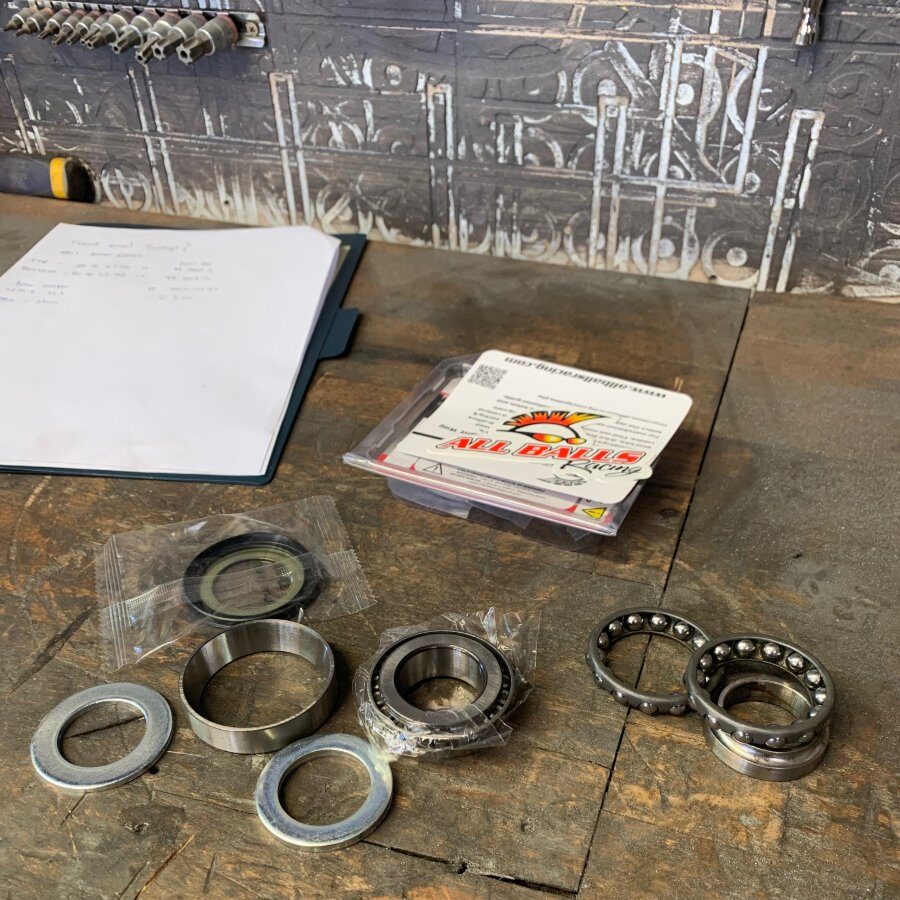
- Rake: A quick search online through a motorcycle specs website will often tell you the rake angle of your bike, and of the front end you’re looking at for the swap. Again the closer you can match the 2 the easier your life will be getting the bike set up to handle well.
- Braking: do you want a twin disc or single disc up front? Does the new front end come with good callipers to achieve a braking upgrade aswell?
- Wheel Size + Type: This can effect the height of your ride and the way it handles, if the front end comes with a spoked wheel it’s a lot easier to change sizes than a cast aluminium wheel. Another point here is if you intend to use the original wheels will the hub accept brake rotors to suit the new front end? The same goes for the axle, older motorcycle axles are often 14-19mm diameter, an axle that’s 25mm or larger might not even fit through your original hub and you’ll be up for a custom spoked hub or left hunting for a suitable replacement.
- Head stem diameter and Length: More often than not, All Balls Bearings will be able to supply a suitable set of headstem bearing to suit the new diameter of headstem to the neck of your bike. Unless of course its drastically different. Same goes with the headstem length, if it lands close to the length of your standard front end you can often get away without making or modifying a headstem on your USD fork swap.
- Handlebar type: This will be dictated by the type of riding you’ll do. Again its an easy check and getting the right type of front end with a suitable top clamp can save you time and dollars having a custom clamp machined.
With all those things considered you should almost be ready to get hunting for that front end. I might have even missed something that’s important to your particular build, but that’s my list.
Where to source fork conversion parts
Finding the forks
The internet is a wonderful place and has opened us up to wreckers from all over the world. I will always start with local motorcycle wreckers or privateers through Ebay, Facebook and Gumtree (Australias Craigslist). If that fails, I broaden my search into overseas places. This can sometimes even save you money including postage costs…. Go figure that one out.
USD fork Conversion bearings
AllBalls bearings has a great resource for double checking that the correct bearings exist for your application when doing a USD fork swap. Before you buy the front end of your dreams check in at the link below to make sure you can get the right bearings for the conversion. A reminder that just because the bearings exist doesn’t mean the headstem length will work right off the bat. For those in the UK, Pyramid Parts also do a number of conical roller bearings suitable for this type of conversion.
You need to measure the internal and external diameter as well as height of the bearings. Working with the original and what you now have work out what size you need and get em!
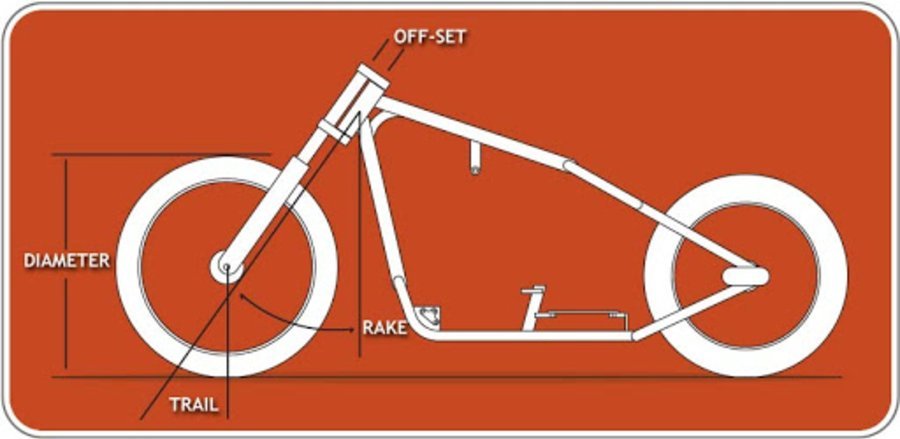
Rake, Trail and Offset on your bike
This is a huge topic that I’m not completely qualified to school you on. Changing one thing, will affect the other and between each of these are nuances on how each change will affect how your bike handles. First let me define each of the three:
Rake: The angle of the steering head of the frame from vertical.
From what I’ve seen sports bikes generally have less rake angle, as steep as 23 degrees. This makes the steering more twitchy and sharp. Steering dampers can really help to maintain stability on the pointy end of this variable.
Tourers and adventure bikes can range from 25-29 Degrees
Cruisers will sit in the high 20’s and up to about 34 degrees. Better for stability at speed, but makes low speed cornering heavier.
If you want to get stupid with it, go build a bike at 45 deg rake and have yourself a time. I’m not your dad, so I won’t tell you what to do. There will be exceptions to the above but in my research and experience that’s what I’ve found.
Trail: A distance measurement made between the axis of the steering head where it meets the ground and the contact patch of the tyre.
Bike dependant I’ll aim for a trail measurement of between 70-100mm. That said it depends on what the bike was originally.
Measuring bikes and hunting for details I’ve seen between 50mm on sport bikes and 130mm on a more raked out front end.
Having negative or minimal trail will make your bike unstable on the front end. I’ve never ridden a bike set up that poorly, but I wouldn’t line up to do it either.
The relationship between these 3 concepts is illustrated pretty well below, thanks to ASK Mo.
Offset: A motorcycles offset is the distance from the center of the steering stem, to the center of the fork tubes. The offset is a design parameter that helps to control the trail of a motorcycle without changing the rake.
The larger the offset, the lower the trail.
Less offset, more trail which will allow steeper steering angle.
Wheel size comes into play and offset can be used to correct a change in wheel size and maintain good trail.
From factory the rake angle will be the same as the fork angle. Although specialty triple clamps exist to add or reduce the fork angle with will effect the trail in a different way. These can be used to achieve a certain aesthetic, but maintain good steering capability.
To avoid a novel blog post, I’ll list below a number of things that affect these figures when building a custom bike. If you think its relevant to you go for a deep dive and get learned.
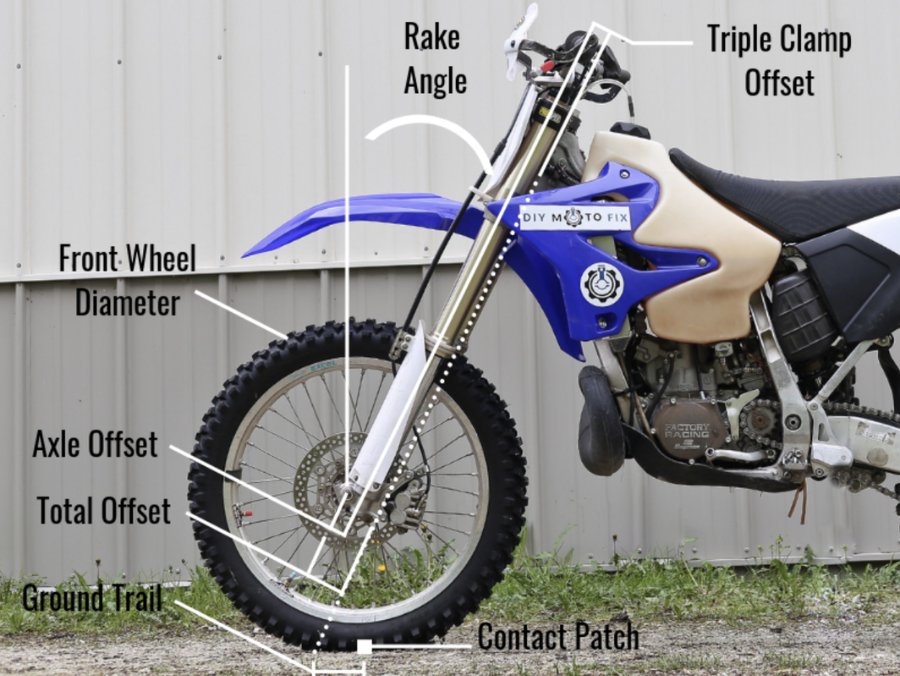
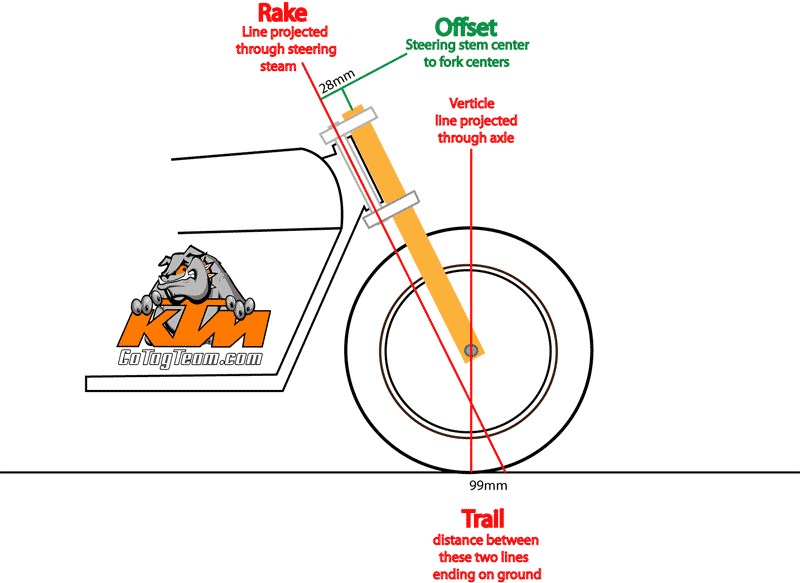
Variables that can affect acceptable steering geometry:
- Wheel Size – Smaller or Larger rim sizes
- Triple clamp offset – fork angle different to steering head angle
- Axle offset – Moving the axle forward of the fork tubes
- Changing ride height- If you lower or raise your bike disproportionately on the front to rear
- Steering Offset – As described above
- Weight distribuition – Load placed on front and rear tyres
- Steering Dampers
During all my research and numerous conversations with people far smarter than I am what I’ve discovered is this: There is no exact right answer, rather a set of pre-defined norms that create a commonly accepted set of parameters depending on what your motorcycle is built to do. Racers move these values around between tracks on different weekends, and according to rider preference. Now you don’t have a race mechanic handy, but I bring that up to say that as long as you’re within these pre-defined safe zones, experimenting to find what work for you isn’t out of reach. Just make sure you do it safely.
I think that’s probably enough out of me for now. There’s a lot to take in here, but with that you should be able to make a better informed decision on which way to go with your chosen bike project. Definitely a lot more info than I started out with. If you have anything to add, please drop me a comment below, this isn’t me on a pedestal shouting down at anyone, its more of a conversation so make sure you get involved if you have something to add.
-
Black Box + 2 Switches Kit
通常価格 $365.00通常価格単価 あたり$365.00セール価格 $365.00 -
Bar End Mirror Kit
通常価格 $145.00通常価格単価 あたり$145.00セール価格 $145.00 -
Headlight Kit
通常価格 $370.00から通常価格単価 あたり$370.00セール価格 $370.00から -
Black Box + 1 Switch Kit
通常価格 $280.00通常価格単価 あたり$280.00セール価格 $280.00
WE BUILD BIKES WITH PURPOSE.
Purpose Built Moto is home for unique custom motorcycle builds. We offer a unique motorcycle customizing experience in the heart of the Gold Coast.










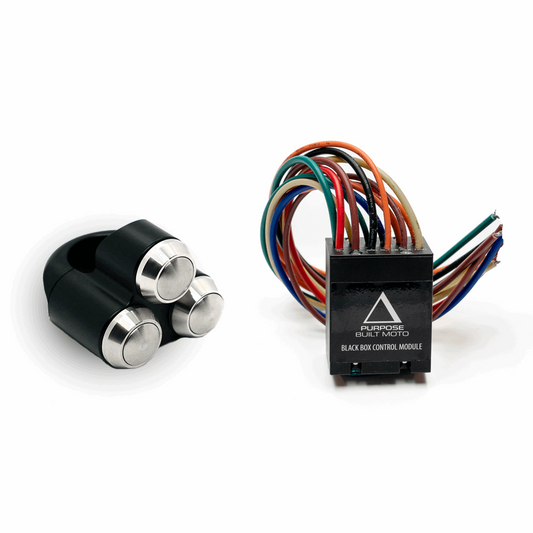



44件のコメント
That should be fine, as long as the extended tube doesn’t foul on your handlebars or any other parts
Hi I borght a complete fork off eBay. Said it was correct one for bike but turns out the tube 1 inch longer than original one. Is it ok if I fit this adjusting at yoke. All other dimensions correct. So if I place it 1 inch raised at yoke will it be ok
GREAT article! You’ve expanded my knowledge greatly with your perspective. Thanks Tom!
+1
Great article, thank you!
Hey Zack,
That’s a bigger question of what you want to be doing with your bike. As I say in the blog, just check and measure before you pull the trigger.
There’s a general guide on what sort of bikes use what amount of steering angle there to help you along the way.
Take your time and you’ll figure it out!
Wow! Best description I’ve seen of this voodoo subject. Really helpful. I’m interested in a lifted scrambler build. I was thinking I’d need to keep my frame level, but now I’m thinking,.. I might be able to raise or lower the rear height to adjust the rake to match the frame the forks/triple tree/ front wheel came from. Thoughts?
happy we could help mate!